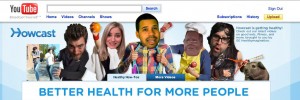Online-Video Marketing That… Doesn’t Feel Like Advertising
GE launched a health campaign today on YouTube that is part of trend toward softer advertising that, I believe, will have better long-term dividends even if it’s hard to measure.
GE is taking a lightly branded approach to promoting health and wellness by sponsoring a “Healthymagination” challenge among people on YouTube. There’s very subtle branding from GE, and no “drive to healthymagination.com” play. In fact the company is not trying to build a microsite, and is aggregating commissioned videos on Howcast’s YouTube channel. Now millions of people will watch and participate in health-challenge videos by iJustine, Alphacat, Rhett & Link, Smosh, me and other YouTube people with large followings.
This is about as far from an intrusive yet measurable pre-roll advertisement as you can get, but GE’s brand will now be associated with health — broadly across a number of demographics.

As someone participating in this health challenge, I am certainly biased. So let’s look instead at Pfizer’s YouTube homepage advertising “takeover” in January, which was centered around videos the company commissioned about health and fitness. The promoted brand (Chantix for smoking cessation) was present but not “in your face.” The insight that may have spawned this approach? Smokers aren’t exactly going to dive into a video channel about quitting.
In a current campaign with a similar “hands off” approach, Rhett and Link’s I Love Local Commercials campaign was sponsored by Microbilt. But the video series is a celebration of cheesy local ads for small business (Microbilt’s target). There’s no forced messages about how Microbilt offers credit, debt collection or background screening to small businesses. People can get excited about cheesy commercials or health (especially when a charity benefits). But it’s hard to get jazzed about debt collection, smoking cessation or light bulbs. It’s the same reason I used Mr. Complicated to promote Clear Point (who cares about staffing technology?).
Brian Bradley, MicroBilt’s EVP of Strategy & Emerging Markets, acknowledges it’s hard to put an ROI on programs like this (parenthetically I addressed this topic on Tuesday at a marketing conference, and here’s the deck).
“Although the initial work that lead to “I Love Local Commercials” was very spontaneous, it is part of a body of work at MicroBilt focused on building awareness and establishing thought leadership across market segments, ” Bradley told me via e-mail. “So that our traditional marketing and sales efforts are more successful.” Bradley said, for example, that if his sales people call a business prospect who hasn’t heard of MicroBilt, they can quickly find out it’s a real company.
It’s tempting for us marketers to force our brand so we can realize (or assume) a near-term ROI. But sometimes the most effective long-term strategy is to have a gentle presence while something bigger, more interesting, and more entertaining takes center stage. This is more instinctive to corporate communication or public-relations people, but they’re generally without budgets to sustain even small pilots like these.
The results may not show up in website visits, instant purchase, and awareness/recall studies. But I would argue that test/control or pre/post qualitative studies (while being cost prohibitive for these case studies), would indicate that target customers have higher favorability of these brands. I don’t think pre-rolls and banners could do that alone.
And isn’t that what separates the AIGs from the Disneys?

Seems like it should be this simple: “Associative branding works.”
Speaking of “gentle presence(s)”, I have ghosts and this is my best ghost capture EVER!
http://www.youtube.com/watch?v=14nEZo0xRE4
I still remember learning as a kid – “GE, we bring good things to life”. Yeah I probably watched too much TV back then.
That G.E. slogan always made me uneasy.
Nalts, I totally agree. One thing I do with all my clients is encourage them to produce videos that are, at their heart, content. Videos that entertain and inform. We tell stories about people, small businesses and large brands that feel real, not forced or commercial.